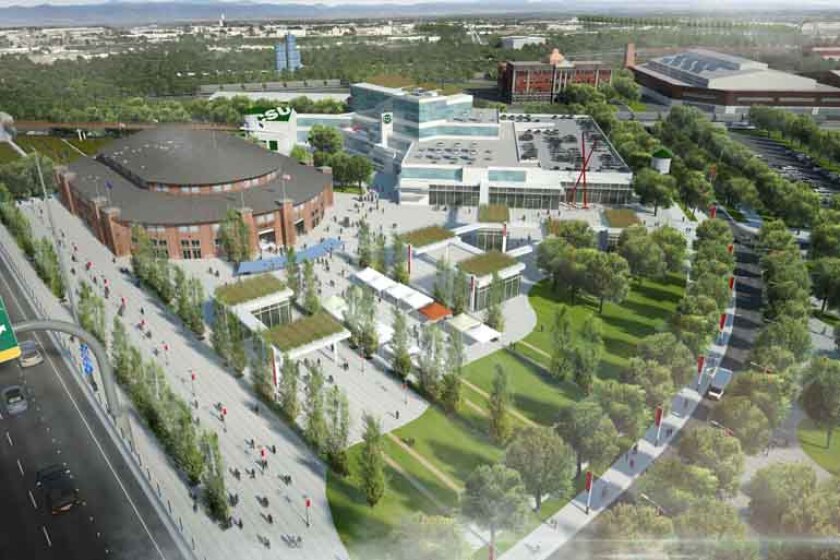When the spaces are used, however, they're for prized and highly anticipated events. So much so that nostalgia often plays a big role in public opinion on what to do with the land. Public officials in Nashville learned that a few years ago when they wanted to redevelop the Tennessee State Fairgrounds and push some activities elsewhere. The proposal hit a wall of opposition from those who called the grounds part of the city’s fabric. Lawmakers abandoned the idea.
But in Denver, home of the National Western Stock Show, officials think they’ve found the answer. After years of brainstorming and failed attempts to put the 270-acre site in use year-round, the city approved an $856 million redevelopment that builds on the stock show’s historic significance and repackages it to reflect current trends.
The National Western is one of the last standing remnants of Denver’s Wild West roots. Started in 1905, the show drew thousands from the entire western half of the United States. Intended as a way to drum up farm and livestock business and sales during one of the slowest retail months of the year, the two-week January event, which includes everything from cattle auctions to a rodeo to a trade show, today is the largest of its kind in the country. The stock show is still a point of pride -- locals fought to keep it when operators threatened to move to Aurora a few years ago. Yet, as other industries have grown and flourished, the National Western has remained a stagnant -- and massive -- reminder of the city’s past.
For years, Denver struggled with how to use the site. The problems were numerous. Although at a great access point to two major interstates, the freeways seperate the stock show’s surrounding neighborhood from the rest of the city. A river further isolates the site. It’s located along an industrial corridor that has mostly fallen into disuse. And the site itself is confusing to navigate and buildings are poorly labeled.
“It’s like being on a college campus,” said Tom Clark, CEO of Metro Denver Economic Development Corporation. “Everyone on campus knows where stuff is but you can’t find anything anywhere.”
Denver is not alone in tackling large swaths of land with massive redevelopment plans. Onondaga County wants to build a new amphitheater and housing development on part of the New York State Fairgrounds. And in Detroit, developers are proposing turning the former state fairgrounds site into a housing a development with retail, a school and movie theater. But Denver is unique in its approach to its makeover.

Eagle Staffs and Color Guards kick off the Denver March Powwow at the National Western Complex. (Brian Fraker)
After entertaining ideas from adding a NASCAR racetrack to the site to building a large hotel, Denver embraced its roots. The city, which owns the land, partnered with Colorado State and focused inward. A market feasibility study revealed that Millennials’ interest in natural foods, farm-to-table eating and healthy living generated a natural interest in the stock show.
Along with the state university, known globally for its veterinary science program, Denver is partnering with the Denver Museum of Nature & Science and History Colorado. The idea is to create a whole community based around animal science and agriculture, all while keeping the National Western as the annual showcase. The development would include an equine sports medicine clinic, an equestrian center, a livestock center and showcase. Developers would also add a railroad stop to the complex.
“For the last 30 years, we have been running away from our Cowtown roots,” said Kelly Leid, who heads up the North Denver Cornerstone Collaborative. “But we’ve rediscovered our roots are grounded very much in our past -- around agriculture and the West. So we came up with a slogan: Embrace the cow.”

A rendering of part of the redeveloped area that will include retail, areas for events and exhibits, community gardens and a small urban farm. (Parsons Brinkerhoff National Western Center Team)
Other developments to come later include improving the South Platte Riverfront that borders the site to the west, adding a new arena and exhibition hall and redeveloping Denver’s historic coliseum, which sits just to the south. The city hopes to fill the rest of the space using private investment, specifically bioscience companies, mixed-use housing and retail stores.
Denver is putting up $673 million. About two-thirds of this will come from the extension of certain taxes, pending voter approval this fall. The state is adding nearly $120 million while National Western and Colorado State are contributing a combined $66 million.
The hope is to bring year-round life to a space that showcases Denver’s history and strengths, said Leid. But officials also hope to reconnect this long-ignored part of North Denver to the center city. “The nearest grocery store is over two miles away and almost a third of the people who live in this part of city don’t have a car,” he said. “Even though these neighborhoods are just north of downtown they might as well be 300 miles away.”








